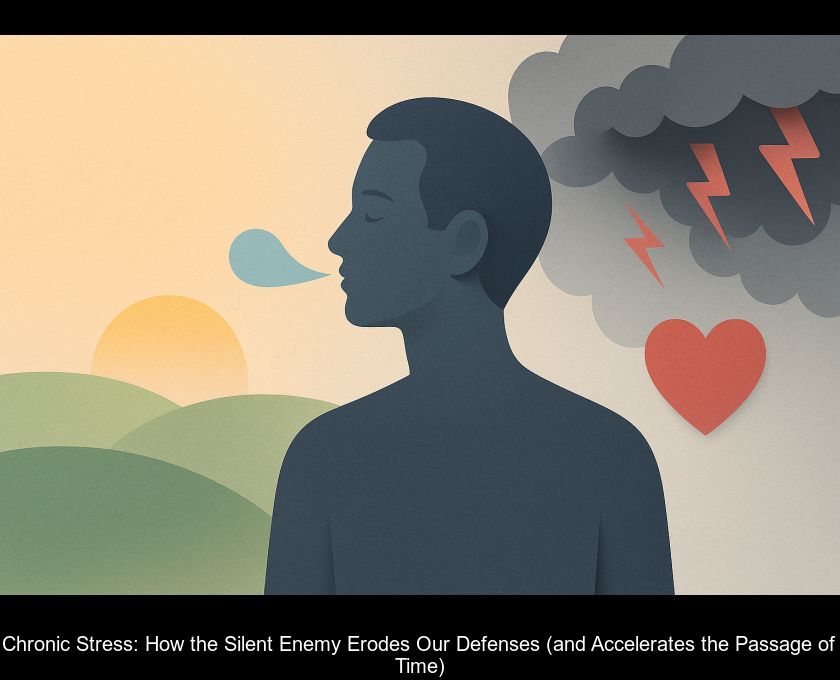Chronic Stress: How The Silent Enemy Erodes Our Defenses (and Accelerates The Passage Of Time)
It does more than just quicken the heartbeat: persistent stress throws our hormones into disarray, fosters a constant low-grade inflammation, and subtly nibbles away at our years of healthy living. Here's a numerical breakdown, without over-dramatizing but also without sugarcoating, along with concrete strategies to catch our breath again.
What is really referred to as "chronic stress"?
In small doses, stress is a superpower: increased adrenaline, sharpened reflexes, mobilized energy. But when the internal alarm gets stuck on "ON" for weeks or months, cortisol levels don't come back down. However, one in three French people say that stress weighs on their daily life, which is more than before the pandemic, even though the curve has slightly declined in 2024.
A biological cascade that overflows
Under prolonged pressure, the hypothalamic-pituitary-adrenal axis goes into overdrive: too much cortisol for too long. As a result, the immune system flounders, blood sugar levels rise, and low-grade inflammation sets in. Recent studies have shown sustained spikes of IL-6, IL-1?, or CRP in individuals (and even... fish) exposed to continuous stress. In humans, this "inflammatory fog" is suspected of fueling diabetes, heart disease, and even some cancers.
The (astronomical) cost for our societies
Behind the dark circles, there are billions. The WHO estimates that 12 billion workdays are lost each year due to depression and anxiety related to stress: a shortfall of about 1 trillion dollars.
In Europe, work-related stress is estimated to cost over 100 billion euros per year when adding up healthcare, absenteeism, and reduced productivity. Imagine the railways, hospitals, or schools that could be funded with this amount...
When stress nibbles away at time (and telomeres)
It's not just about fatigue. A pan-European study conducted in 2025 measured a ten-year advancement in cellular aging in children from disadvantaged backgrounds, simply because their cortisol production was 23% higher.
Telomeres, the DNA caps that protect our chromosomes, shorten faster, opening the door to "aging too soon."
Stress, Immunity... and Cancer: What We Know
Research refines the picture: chronic stress, through inflammation and weakened immunity, may facilitate certain mutations or reduce the body's ability to repair DNA.
A meta-analysis of 51 cohorts found no overall increased risk, but nonetheless pointed to a stronger association for cancers related to smoking, including lung cancer.
The path is multifactorial: tobacco toxicity, lifestyle, decreased natural defenses... everything adds up.
The emotional weight of diagnoses
Conversely, nearly one in four cancer patients suffers from clinical anxiety: a vicious circle where the disease diverts the energy needed for healing.
Again, stress is not just a "soul ache": Inserm reminds us that a depressive mood can increase the mortality of certain cancers by 20 to 80 percent.
Breaking the cycle: five (very) realistic ways to catch a breath.
- Nervous Micro-Breaks, 3 minutes of coherent breathing (inhale for 5 seconds, exhale for 5 seconds) can lower the heart rate by about 7%. Repeat before sending a stern email or during a crowded commute.
- No Need for a Marathon, 150 minutes of brisk walking per week already reduce the risk of depression by 21%, and the risk of cardio-metabolic diseases by 30%. Bonus: the post-exercise dopamine, a true natural antidote.
- Resist Doom-Scrolling, By limiting exposure to anxiety-inducing screens after 10 p.m., we reset melatonin (a major lever against oxidative stress).
- Social Rituals, Saying hello, sharing a coffee, laughing: these are small loops of oxytocin that neutralize cortisol for a moment.
- Mental Check-Up, Just as one measures blood pressure, it's possible, once a year, to evaluate one's stress level with a professional: psychologist, occupational physician, etc. Early intervention is often simpler (and less expensive) than a long-term leave of absence.
Nota Bene,
Cortisol, CRP, IL-6... what are these? Cortisol is the key hormone in the "fight or flight" response. CRP (C-reactive protein) and cytokines IL-6, IL-1?, IL-8 are markers of inflammation; their moderate but persistent elevation often signifies chronic stress.
It's not visible to the naked eye, but a simple blood test can track them.
As a final breath
We will never eliminate all of life's shocks, nor the unexpectedness of a red email at 6 p.m. on a Friday.
But we can strengthen our counterbalances: breathe better, move better, sleep better.
Each small crack opened in the wall of stress releases precious capital: immune defenses ready for action, a clearer brain... and perhaps a few years of higher quality life. The true luxury, after all.









